Seepage Model and Pressure Response Characteristics of Non-Orthogonal Multi-Fracture Vertical Wells with Superimposed Sand Body in Tight Gas Reservoirs
Abstract
:1. Introduction
2. Establishment and Solution of Seepage Model
- (1)
- The tight sandstone gas reservoir presents a circular distribution on the whole. The initial pressure (where initial parameters are the value of the corresponding parameters at starting production) in the whole area is pi, the thickness of the tight sandstone gas reservoir is h and the porosity is φ;
- (2)
- The whole tight sandstone gas reservoir is homogeneous isotropic, in which the initial permeability of the inner zone is kg1, the permeability of the semi-permeable zone is kgm and the initial permeability of the outer zone is kg2;
- (3)
- It is assumed that any hydraulic fracture is distributed in the inner zone and each hydraulic fracture completely opens the reservoir vertically, and that the fracture is distributed in the inner zone laterally without passing through the semi-permeable zone. The half-length of the i fracture is marked as rfi, and the angle between the i fracture and the x-axis is θi;
- (4)
- The hydraulic fracture is a finite conductivity fracture, and the flow in each fracture is independent of each other. The tip of the fracture can be regarded as an impermeable boundary, so the flow of tight sandstone gas into the wellbore through the tip of the fracture is negligible;
- (5)
- Flow patterns throughout the reservoir and in fractures are according to Darcy’s law. Constant production in vertical wells (qsc) is maintained.
3. Model Verification
4. Analysis of Pressure Response Curve and Influencing Factors
4.1. Pressure Response Characteristics
4.2. Influencing Factors of Pressure Response Curve of Multi-Fracture Vertical Wells
- (1)
- Pressure sensitivity
- (2)
- Storage Capacity Ratio of Inner And Outer Areas
- (3)
- Permeability Coefficient
- (4)
- Fracture Symmetry
- (5)
- The Number of Fractures
- (6)
- Fracture Network
5. Discussion
- (1)
- Complex Fracture Networks: One significant aspect that warrants further exploration is the consideration of complex fracture networks after hydraulic fracturing [39,40,41,42,43,44]. In the fracturing process, cross-fracture networks are formed, which can introduce a level of instability in seepage. While our study primarily focused on non-coplanar fractures, it is imperative to delve into the intricate seepage dynamics of cross-fracture networks. Such networks may have unique behaviors and implications for reservoir performance.
- (2)
- Temporary Closure and Opening of Fractures: Our study currently assumes constant conductivity for artificial fractures. However, in the development of tight sandstone gas reservoirs, the gas–water two-phase seepage can result in the temporary closure and opening of these fractures. Neglecting this dynamic behavior limits the accuracy of our models. Therefore, it is essential to undertake research that emphasizes the temporary closure and opening of fractures during the gas–water two-phase seepage process.
- (1)
- Conducting comprehensive studies on cross-fracture networks to understand their influence on seepage stability in tight sandstone gas reservoirs.
- (2)
- Investigating the mechanisms behind the temporary closure and opening of fractures during gas–water two-phase seepage and its impact on reservoir behavior.
6. Conclusions
- (1)
- The phenomenon of superimposed sand body deposition in tight gas reservoirs is common, and the well test curve trends upward and then falls down. This phenomenon is often analyzed based on the constant pressure boundary or radial composite reservoir model, and the inversion results are prone to be misleading. In this paper, a mathematical model of unsteady seepage flow in fractured vertical wells in tight sandstone gas reservoirs is established, which takes into account factors such as stress sensitivity, fracture density and fracture symmetry.
- (2)
- There are great differences in the seepage mechanism at different stages of complex fracture wells with superimposed sand bodies. In the early linear flow stage, interference between the wings plays a dominant role, which lasts to the middle and later production stages. In the middle seepage stage, the interfracture interference plays a dominant role until the boundary control flow appears. Finally, the interference between the wings is reflected in the curve as a “bulge” in the pseudo-pressure derivative, and the interference between the slots will affect the duration of the first radial flow.
- (3)
- For tight sandstone gas reservoirs, cross-fracture networks are formed in the fracturing process. However, the fracture network in this paper only considers non-coplanar fractures and does not study the complex seepage of cross-fracture networks. Therefore, the unstable seepage of such complex fracture networks needs further study.
Author Contributions
Funding
Data Availability Statement
Conflicts of Interest
References
- Zou, C.; Yang, Z.; He, D.; Wei, Y.; Li, J.; Jia, A.; Chen, J.; Zhao, Q.; Li, Y.; Li, J.; et al. Theory, technology and prospect of conventional and unconventional natural gas. Pet. Explor. Dev. 2018, 45, 575–587. [Google Scholar] [CrossRef]
- Jia, C.; Zou, C.; Yang, Z.; Zhu, R.; Chen, Z.; Zhang, B.; Jiang, L. Significant progress of continental petroleum geology theory in the basins of central and western China. Pet. Explor. Dev. 2018, 45, 546–560. [Google Scholar] [CrossRef]
- Feng, Q.; Xu, S.; Xing, X.; Zhang, W.; Wang, S. Advances and challenges in shale oil development: A critical review. Adv. Geo-Energy Res. 2020, 4, 406–418. [Google Scholar] [CrossRef]
- Sun, L.; Zou, C.; Jia, A.; Wei, Y.S.; Zhu, R.K.; Wu, S.T.; Guo, Z. Development characteristics and direction of tight oil and gas in China. Pet. Explor. Dev. 2019, 46, 1015–1026. [Google Scholar] [CrossRef]
- Jiang, Z.; Pang, X.; Li, F.; Wang, P.; Li, Z.; Li, Y.; Xu, Y. Reservoir-forming mechanism and type division of tight sandstone gas reservoirs. Geol. Soc. China 2013, 267–268. [Google Scholar]
- Wang, X. Numerical simulation of low permeability tight sandstone gas reservoir considering stress sensitivity. Petrochem. Appl. 2020, 39, 41–44. [Google Scholar]
- Li, G.; Zhu, R. Development status, challenges and concerns of unconventional oil and gas in PetroChina. China Pet. Explor. 2020, 25, 1–13. [Google Scholar]
- Zhu, Y. Well Testing and Productivity Prediction of Tight Oil and Gas Reservoirs. Master’s Thesis, University of Science and Technology of China, Beijing, China, 2019. [Google Scholar]
- Zhang, F.-Y.; Zou, L.-J.; Rui, Z.-H.; Emami-Meybodi, H.; Ayala, L.F.; Zhang, Z.-X. A two-phase type-curve method with multiscale fluid transport mechanisms in hydraulically fractured shale reservoirs. Pet. Sci. 2023, 20, 2253–2267. [Google Scholar] [CrossRef]
- Wang, Y.; Leng, S.; Deng, J.; Lu, X.; Chen, J. Sand body architecture characteristics of lower Member of Hehe 8 in Western Sulige Gas Field. Inn. Mong. Petrochem. Ind. 2022, 48, 108–113. [Google Scholar]
- Kuchuk, F.; Biryukov, D.; Fitzpatrick, T.; Morton, K. Pressure transient behavior of horizontal wells intersecting multiple hydraulic and natural fractures in conventional and unconventional unfractured and naturally fractured reservoirs. In Proceedings of the SPE Annual Technical Conference and Exhibition, Houston, TX, USA, 28–30 September 2015. Paper SPE 175037. [Google Scholar]
- Wang, S.; Qin, C.; Feng, Q.; Javadpour, F.; Rui, Z. A framework for predicting the production performance of unconventional resources using deep learning. Appl. Energy 2021, 295, 117016. [Google Scholar] [CrossRef]
- Li, J. Research on Dynamic Analysis of Fractured Horizontal Well. Ph.D. Thesis, China University of Geosciences, Beijing, China, 2005. [Google Scholar]
- Wan, J.; Aziz, K. Semi-analytical well model of horizontal wells with multiple hydraulic fractures. Soc. Pet. Eng. J. 2002, 7, 437–445. [Google Scholar] [CrossRef]
- Fan, D.; Yao, J.; Wang, Z.; Zhang, G. Interpretation of well testing of fractured horizontal Wells based on different dip angles. Res. Prog. Hydrodyn. 2009, 6, 705–712. [Google Scholar]
- Zerar, Z.; Bettam, Y. Interpretation of multiple hydraulically fractured horizontal wells in closed systems. In Proceedings of the Canadian International Petroleum Conference, Calgary, AB, Canada, 8–10 June 2004. [Google Scholar]
- Meng, M.; Chen, Z.; Liao, X.; Wang, J.; Shi, L. A well-testing method for parameter evaluation of multiple fractured horizontal wells with non-uniform fractures in shale oil reservoirs. Adv. Geo-Energy Res. 2020, 4, 187–198. [Google Scholar] [CrossRef]
- Cui, G.; Pei, S.; Rui, Z.; Dou, B.; Ning, F.; Wang, J. Whole process analysis of geothermal exploitation and power generation from a depleted high-temperature gas reservoir by recycling CO2. Energy 2021, 217, 119340. [Google Scholar] [CrossRef]
- Zhang, L.; Kou, Z.; Wang, H.; Zhao, Y.; Dejam, M.; Guo, J.; Du, J. Performance analysis for a model of a multi-wing hydraulically fractured vertical well in a coalbed methane gas reservoir. J. Pet. Sci. Eng. 2018, 166, 104–120. [Google Scholar] [CrossRef]
- Wang, H.; Kou, Z.; Guo, J.; Chen, Z. A semi-analytical model for the transient pressure behaviors of a multiple fractured well in a coal seam gas reservoir. J. Pet. Sci. Eng. 2021, 198, 108159. [Google Scholar]
- Zou, W.; Yu, H.; Guo, J.; Shi, M. Fractal well test model for multi-wing fractured vertical well with finite conductivity in the coal bed methane reservoir. J. Northeast. Pet. Univ. 2021, 45, 102–110. [Google Scholar]
- Zhao, K.; Du, P. Performance of horizontal wells in composite tight gas reservoirs considering stress sensitivity. Adv. Geo-Energy Res. 2019, 3, 287–303. [Google Scholar] [CrossRef]
- Bouchaala, F.; Ali, M.Y.; Matsushima, J. Estimation of seismic attenuation in carbonate rocks using three different methods: Application on VSP data from Abu Dhabi oilfield. J. Appl. Geophys. 2016, 129, 79–91. [Google Scholar] [CrossRef]
- Jouini, M.S.; Bouchaala, F.; Riahi, M.K.; Sassi, M.; Abderrahmane, H.; Hjouj, F. Multifractal analysis of reservoir rock samples using 3D X-ray micro computed tomography images. IEEE Access 2022, 10, 67898–67909. [Google Scholar] [CrossRef]
- Yao, J.; Yin, X.; Fan, D.; Sun, Z. Three-linear flow test model for fractured horizontal Wells in low permeability reservoir. Oil Gas Well Test. 2011, 20, 1–5. [Google Scholar]
- Wang, X.; Luo, W.; Hou, X.; Wang, J. Unsteady pressure analysis of multi-stage fractured horizontal well in rectangular reservoir. Pet. Explor. Dev. 2014, 41, 74–78. [Google Scholar] [CrossRef]
- Amini, S. Development and Application of the Method of Distributed Volumetric Sources to the Problem of Unsteady-State Fluid Flow in Reservoirs. Ph.D. Thesis, Texas A&M University, College Station, TX, USA, 2007. [Google Scholar]
- Bear, J.; Braester, C.; Menier, P.C. Effective and relative permeabilities of anisotropie porous media. Transp. Porous Media 1987, 2, 301–316. [Google Scholar] [CrossRef]
- Hantush, M.N. Non-steady Green’s functions for an infinite strip of leaky aquifer. Trans AGU 1955, 36, 101–104. [Google Scholar] [CrossRef]
- Boussila, A.K.; Tiab, D.; Owayed, J. Pressure Behavior of Well Near a leaky Boundary in Heterogeneous Reservoirs. J. Pet. Technol. 2003, 27, 89–96. [Google Scholar]
- Rahman, N.M.; Miller, M.D.; Mattar, L. Analytical Solution to the Transient-Flow Problems for a Well Located near a Finite-Conductivity Fault in Composite Reservoirs. Soc. Pet. Eng. 2003, 96, 120–139. [Google Scholar]
- Escobar, F.; Fahes, M.; Gonzalez, R.; Pinchao, D.M.; Zhao, Y.L. Determination of Reservoir Drainage Area for Constant-Pressure Systems by Conventional Transient Pressure Analysis. ARPN J. Eng. Appl. Sci. 2015, 10, 5193–5199. [Google Scholar]
- Abdelaziz, B.; Tiab, D. Pressure Behaviour of a Well between Two Intersecting Leaky Faults. In Proceedings of the Canadian International Petroleum Conference, Calgary, AB, Canada, 8–10 June 2004. Paper PETSOC-2004-209. [Google Scholar]
- Jongkittinarukorn, K.; Tiab, D.; Escobar, F.H. Interpretation of Horizontal Well Performance in Complicated Systems by the Boundary Element Method. Paper SPE 50437. In Proceedings of the SPE International Conference on Horizontal Well Technology, Calgary, AB, Canada, 1–4 November 1998. [Google Scholar]
- Wang, Y.; Ayala, L.F. Explicit Determination of Reserves for Variable-Bottomhole-Pressure Conditions in Gas Rate-Transient Analysis. Soc. Pet. Eng. 2020, 25, 1936–1945. [Google Scholar] [CrossRef]
- Zhu, W.; Yang, X. Action mechanism of water on the gas seepage capacity in tight gas reservoir. Spec. Oil Gas Reserv. 2019, 26, 128–132. [Google Scholar]
- Liu, P.; Guo, H.; Zhang, X.; Shen, R.; Li, H. Experimental Study on Mechanism of Water Sensitivity and Water Lock Damage in Tight Gas Reservoir. Bull. Sci. Technol. 2019, 35, 103–108. [Google Scholar]
- Ouyang, L.B.; Petalas, N.; Arbabi, S.; Schroeder, D.E.; Aziz, K. An experimental study of single-phase and two-phase fluid flow in horizontal wells. In Proceedings of the SPE Western Regional Meeting, Bakersfield, CA, USA, 10–13 May 1998. Paper SPE 46221. [Google Scholar]
- Luo, S.; Ding, C.; Cheng, H.; Zhang, B.; Zhao, Y.; Liu, L. Estimated ultimate recovery prediction of fractured horizontal wells in tight oil reservoirs based on deep neural networks. Adv. Geo-Energy Res. 2022, 6, 111–122. [Google Scholar] [CrossRef]
- Bunger, A.P.; Zhang, X.; Jeffrey, R.G. Parameters affecting the interaction among closely spaced hydraulic fractures. SPE J. 2012, 17, 292–306. [Google Scholar] [CrossRef]
- Carter, B.J.; Desroches, J.; Ingraffea, A.R.; Wawrzynek, P.A. Simulating fully 3D hydraulic fracturing. Model. Geomech. 2000, 200, 525–557. [Google Scholar]
- Asadi, M.B.; Zendehboudi, S. Evaluation of productivity index in unconventional reservoir systems: An extended distributed volumetric sources method. J. Nat. Gas Sci. Eng. 2019, 61, 1–17. [Google Scholar] [CrossRef]
- Wu, Z.; Cui, C.; Jia, P.; Wang, Z.; Sui, Y. Advances and challenges in hydraulic fracturing of tight reservoirs: A critical review. Energy Geosci. 2022, 3, 427–435. [Google Scholar] [CrossRef]
- Chu, H.; Zhang, J.; Zhang, L.; Ma, T.; Gao, Y.; Lee, W.J. A new semi-analytical flow model for multi-branch well testing in natural gas hydrates. Adv. Geo-Energy Res. 2023, 7, 176–188. [Google Scholar] [CrossRef]
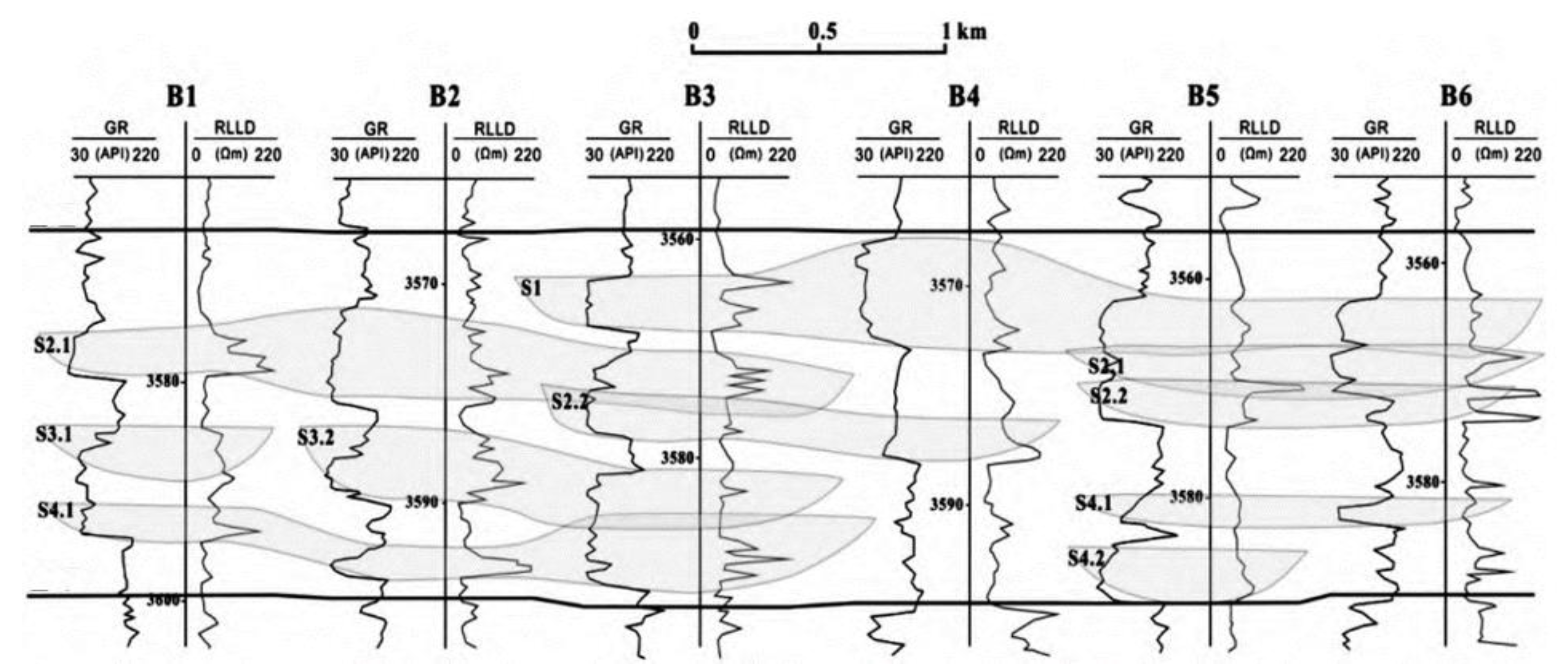



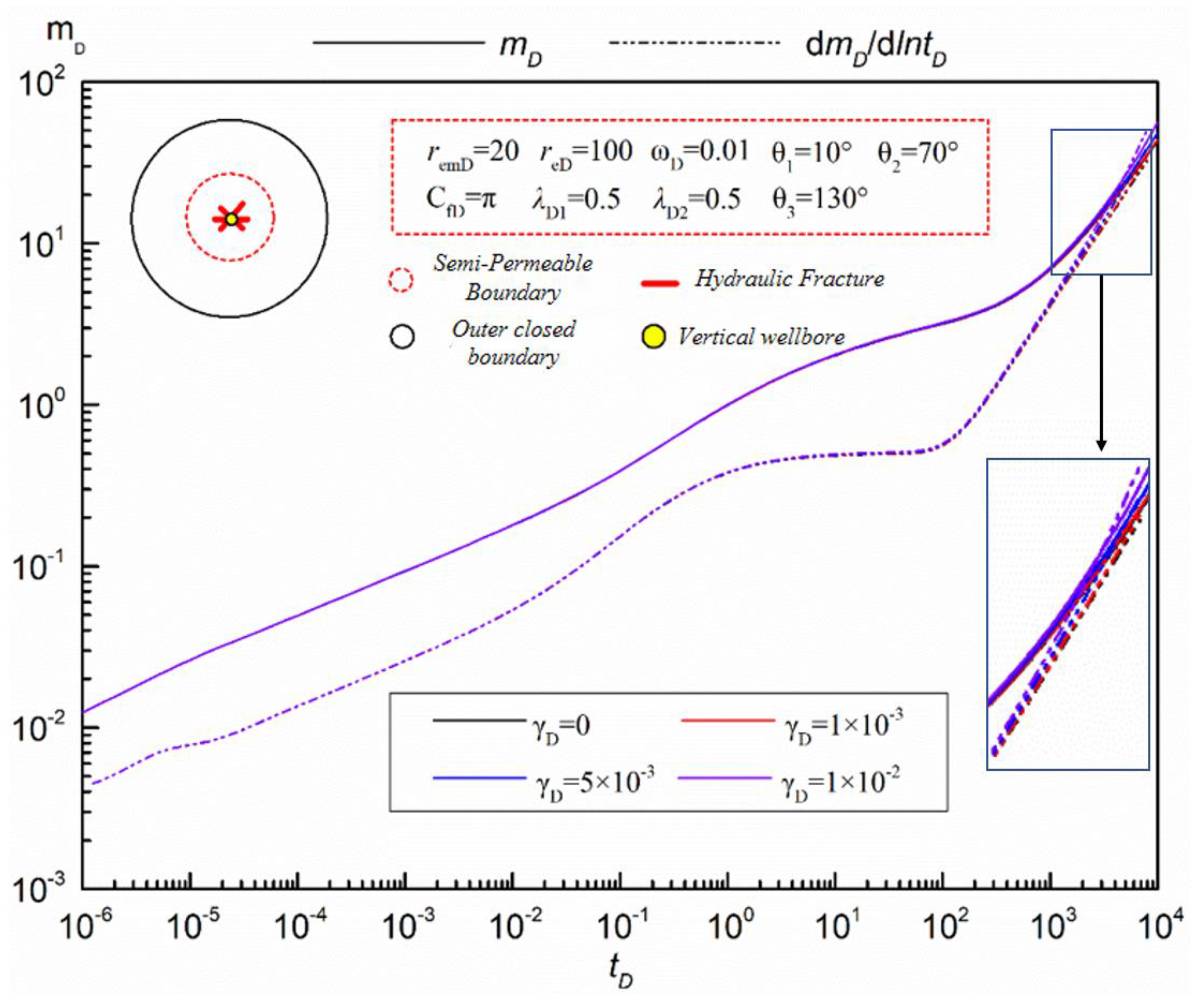
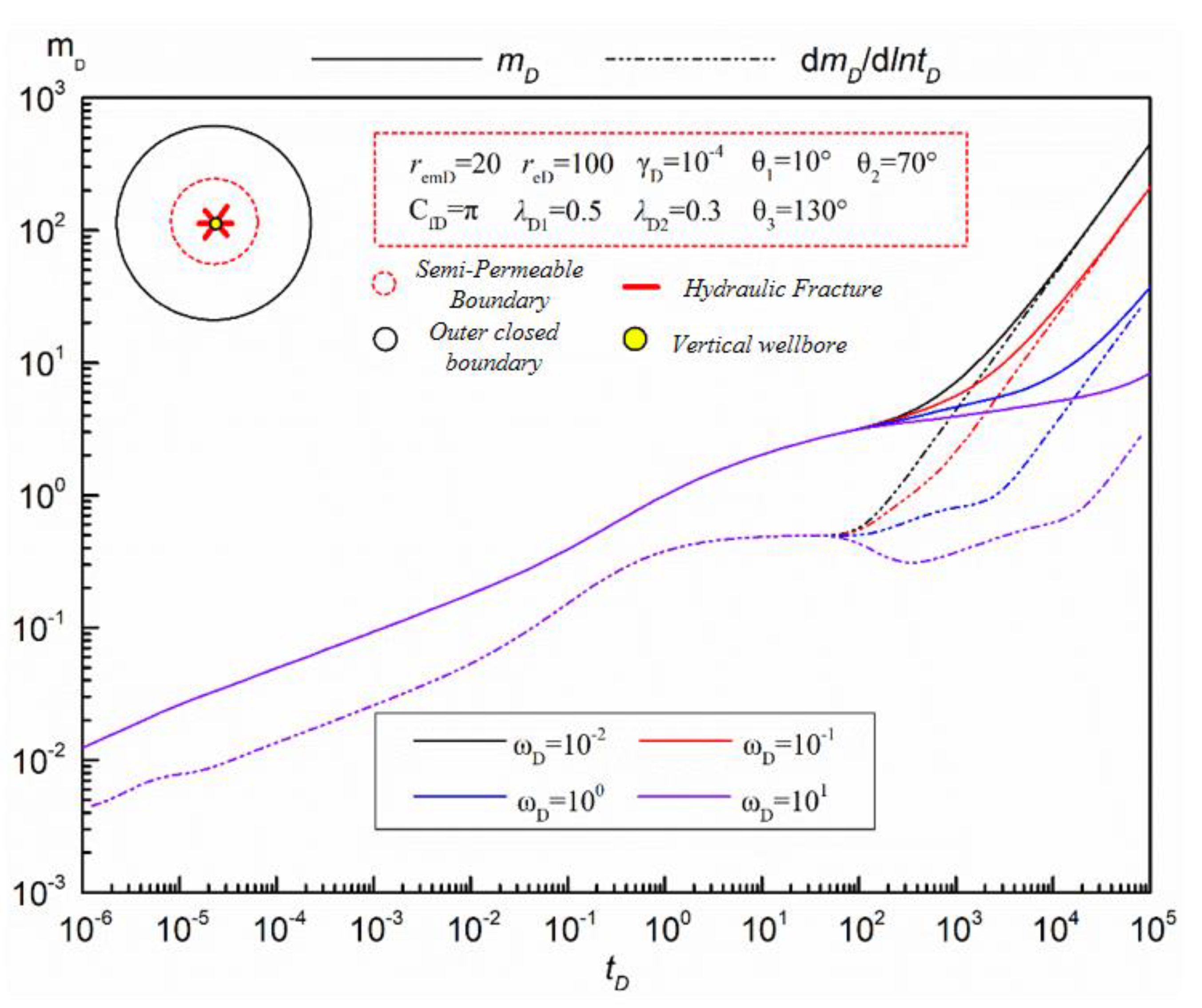
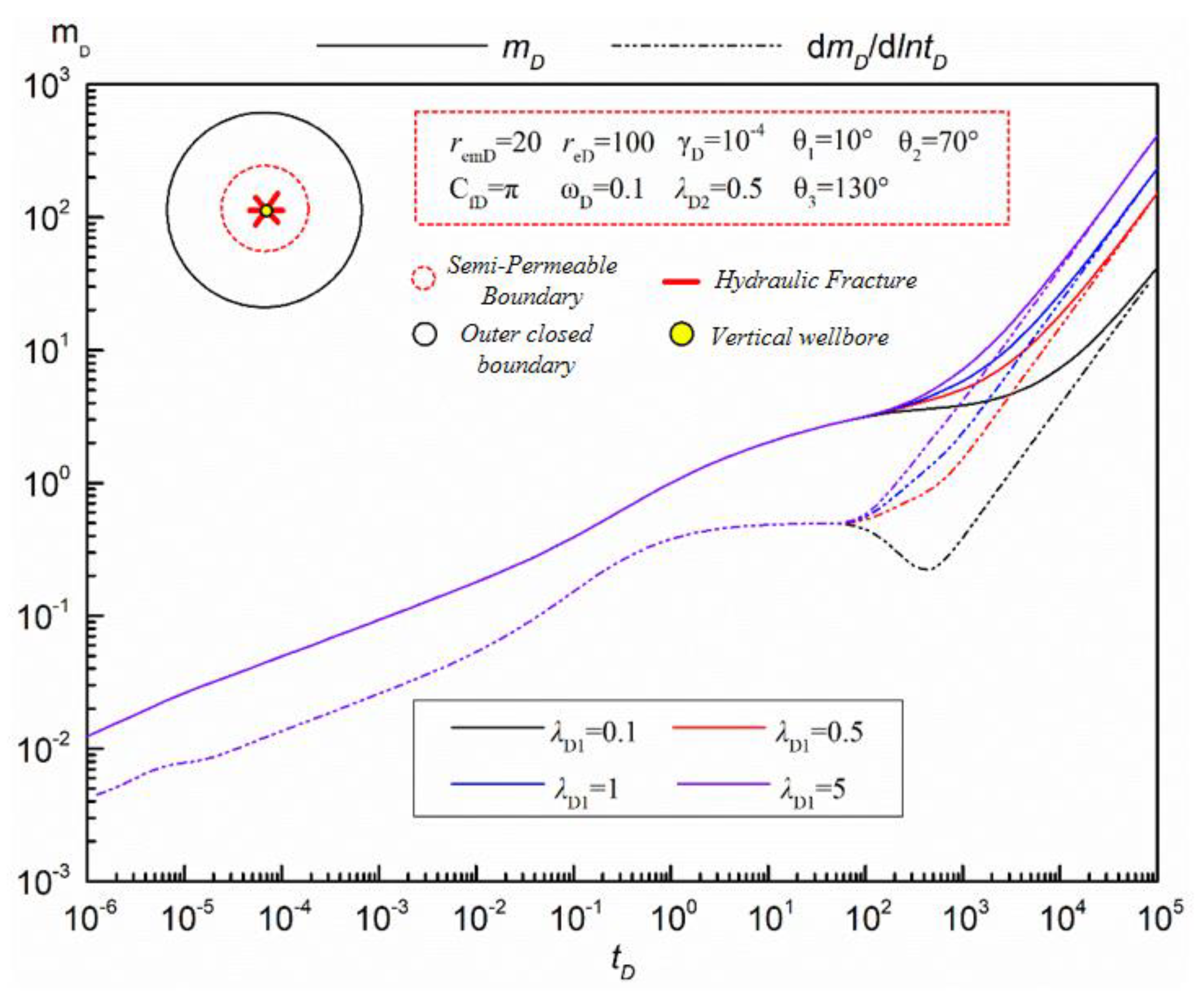
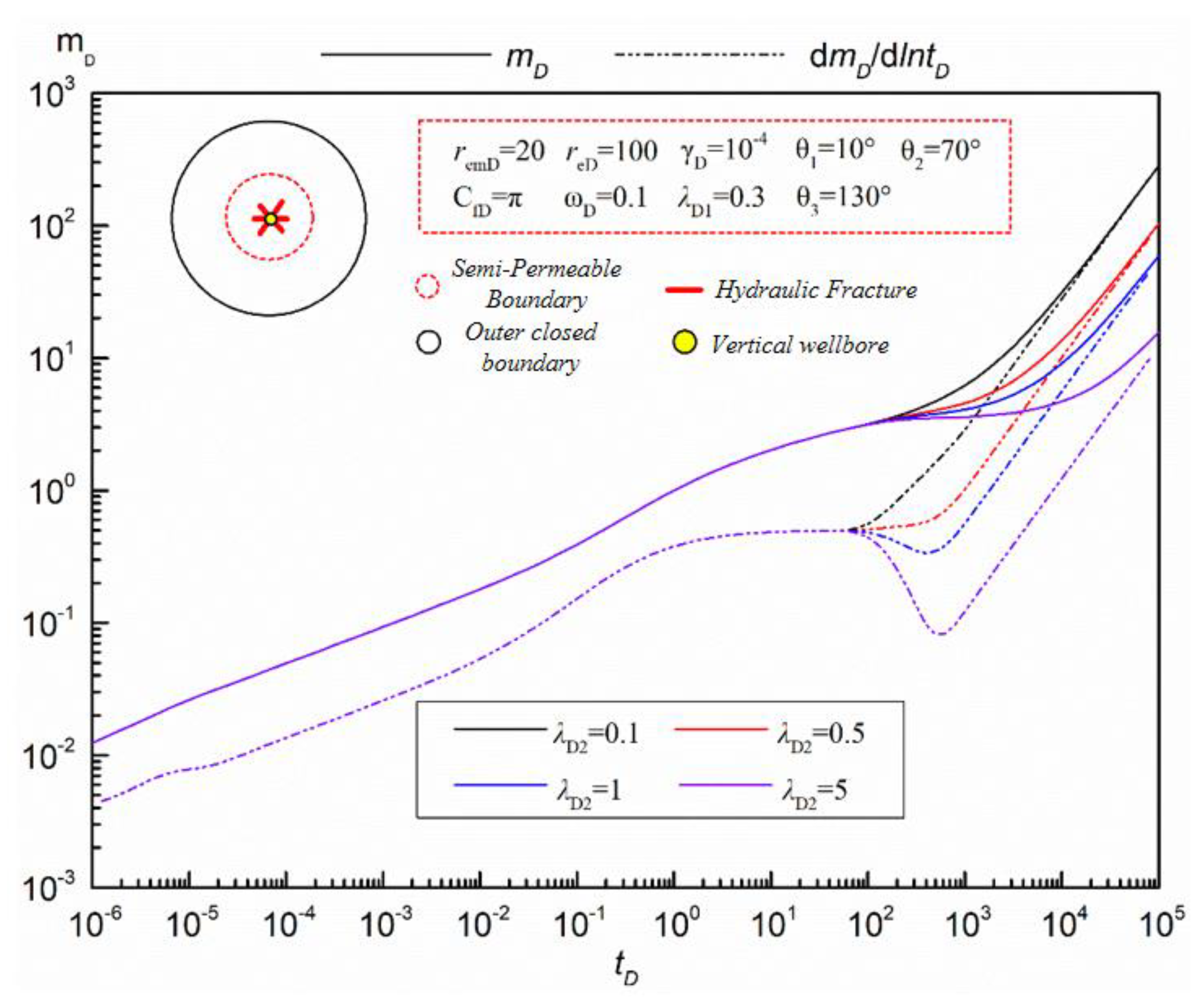

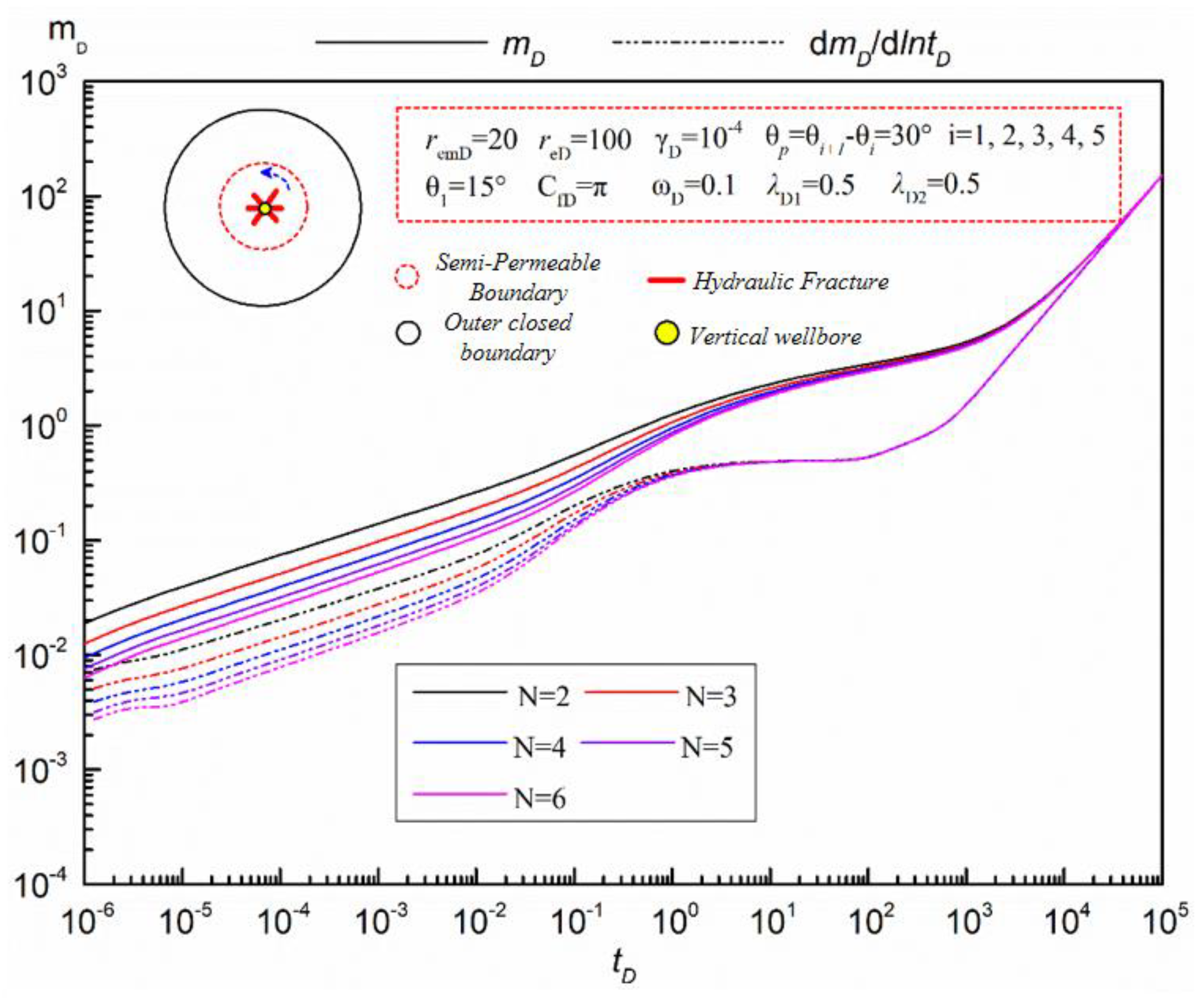

Disclaimer/Publisher’s Note: The statements, opinions and data contained in all publications are solely those of the individual author(s) and contributor(s) and not of MDPI and/or the editor(s). MDPI and/or the editor(s) disclaim responsibility for any injury to people or property resulting from any ideas, methods, instructions or products referred to in the content. |
© 2023 by the authors. Licensee MDPI, Basel, Switzerland. This article is an open access article distributed under the terms and conditions of the Creative Commons Attribution (CC BY) license (https://creativecommons.org/licenses/by/4.0/).
Share and Cite
Zhou, Z.; Xia, A.; Guo, R.; Chen, L.; Kong, F.; Zhao, X. Seepage Model and Pressure Response Characteristics of Non-Orthogonal Multi-Fracture Vertical Wells with Superimposed Sand Body in Tight Gas Reservoirs. Energies 2023, 16, 7275. https://doi.org/10.3390/en16217275
Zhou Z, Xia A, Guo R, Chen L, Kong F, Zhao X. Seepage Model and Pressure Response Characteristics of Non-Orthogonal Multi-Fracture Vertical Wells with Superimposed Sand Body in Tight Gas Reservoirs. Energies. 2023; 16(21):7275. https://doi.org/10.3390/en16217275
Chicago/Turabian StyleZhou, Ziwu, Ao Xia, Rui Guo, Lin Chen, Fengshuo Kong, and Xiaoliang Zhao. 2023. "Seepage Model and Pressure Response Characteristics of Non-Orthogonal Multi-Fracture Vertical Wells with Superimposed Sand Body in Tight Gas Reservoirs" Energies 16, no. 21: 7275. https://doi.org/10.3390/en16217275




